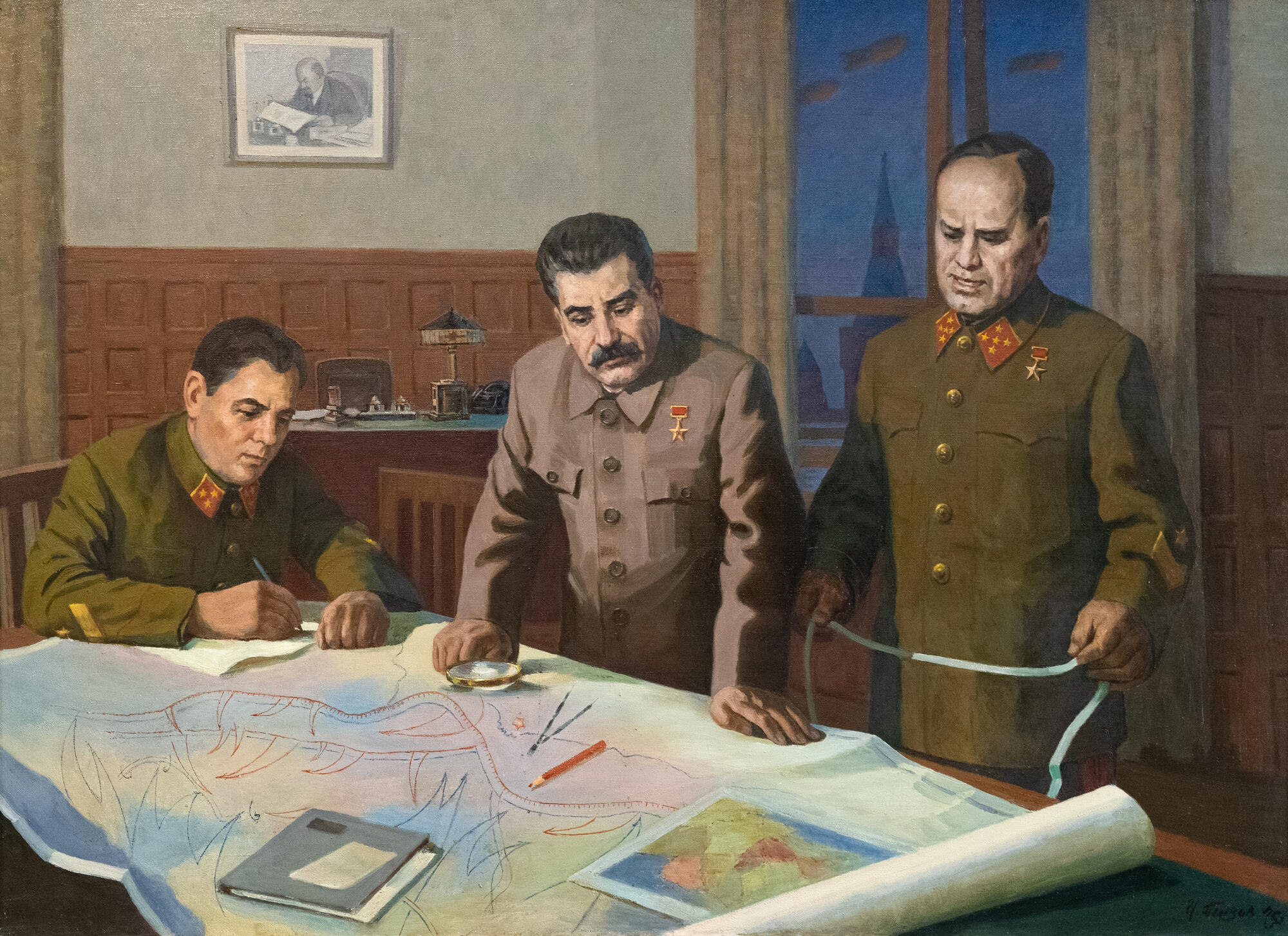The Victory Museum houses a series of portraits of Soviet military commanders. One of them is titled “Hard Times” and was created by the talented military artist Ivan Penzov.
Ivan Penzov was a Hero of the Soviet Union, a People’s Artist of the Russian Federation, and an Honored Artist of the RSFSR. He created a series of portraits of Soviet state leaders, admirals, and generals — both former and acting commanders of the navy forces. His life journey was truly unique. He fought in the Battle of Kursk, was later captured, and escaped from a concentration camp. He spent a long time healing the wounds and became a painter. For his service in battle, Ivan Penzov was awarded the title of the Hero of the Soviet Union.
In this painting, he depicted a council of military commanders. During the Great Patriotic War, a new government agency was established under the name of the Headquarters of the Main Command. Its composition underwent several reforms. At first, it was headed by Marshal Semyon Timoshenko. On July 10, 1941, it was transformed into the Headquarters of the High Command by Decree No. 10 of the State Defense Committee. It was done to ensure more centralized and faster management of the armed forces. The reformed agency was headed by Joseph Stalin, Chairman of the State Defense Committee. On August 8, 1941, he was appointed Supreme Commander of the Armed Forces. The agency was renamed the Headquarters of the Supreme High Command. During the war, it was the main military authority of the Soviet Union.
Throughout the entire Great Patriotic War, the Headquarters was located in Moscow. The members of the Headquarters gathered in Stalin’s Kremlin office. In October 1941, when the German forces started bombing Moscow, the Headquarters moved from the Kremlin to an old mansion on Kirov Street. The building was equipped with reliable offices and communications. During the bombing, the work moved to the Kirovskaya Metro Station, where an underground strategic center had been prepared. According to Georgy Zhukov, the fact that the Headquarters never left Moscow even during the toughest times was “of great significance for the morale”.
After the war, the Headquarters of the Supreme Command was abolished and superseded by the General Staff of the Armed Forces of the USSR.
Ivan Penzov was a Hero of the Soviet Union, a People’s Artist of the Russian Federation, and an Honored Artist of the RSFSR. He created a series of portraits of Soviet state leaders, admirals, and generals — both former and acting commanders of the navy forces. His life journey was truly unique. He fought in the Battle of Kursk, was later captured, and escaped from a concentration camp. He spent a long time healing the wounds and became a painter. For his service in battle, Ivan Penzov was awarded the title of the Hero of the Soviet Union.
In this painting, he depicted a council of military commanders. During the Great Patriotic War, a new government agency was established under the name of the Headquarters of the Main Command. Its composition underwent several reforms. At first, it was headed by Marshal Semyon Timoshenko. On July 10, 1941, it was transformed into the Headquarters of the High Command by Decree No. 10 of the State Defense Committee. It was done to ensure more centralized and faster management of the armed forces. The reformed agency was headed by Joseph Stalin, Chairman of the State Defense Committee. On August 8, 1941, he was appointed Supreme Commander of the Armed Forces. The agency was renamed the Headquarters of the Supreme High Command. During the war, it was the main military authority of the Soviet Union.
Throughout the entire Great Patriotic War, the Headquarters was located in Moscow. The members of the Headquarters gathered in Stalin’s Kremlin office. In October 1941, when the German forces started bombing Moscow, the Headquarters moved from the Kremlin to an old mansion on Kirov Street. The building was equipped with reliable offices and communications. During the bombing, the work moved to the Kirovskaya Metro Station, where an underground strategic center had been prepared. According to Georgy Zhukov, the fact that the Headquarters never left Moscow even during the toughest times was “of great significance for the morale”.
After the war, the Headquarters of the Supreme Command was abolished and superseded by the General Staff of the Armed Forces of the USSR.



